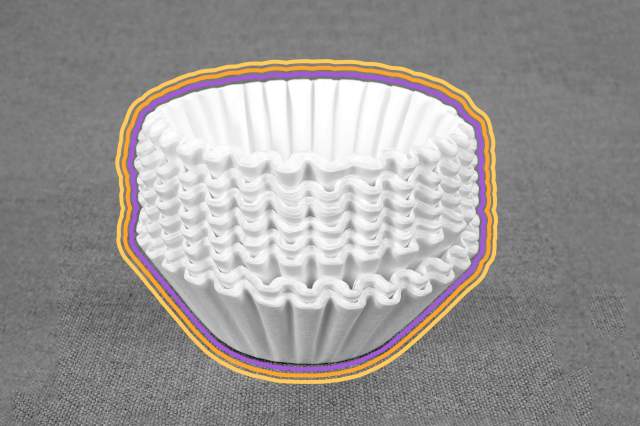
Disposable Coffee Filters
Melitta Bentz’s invention is one coffee drinkers now take for granted, but it was revolutionary in the early 1900s. At the time, other home brewing methods required a lot of time and cleanup — not to mention a tolerance for bitter coffee and sludgy grounds at the bottom of your mug. While pricey cloth coffee filters were available, they were used like tea bags, steeping grounds in hot water that produced a subpar cup and an extraordinary mess. Many coffee connoisseurs brewed their morning java in percolators, but those could leave a burnt taste and failed to filter out smaller grounds.
Bentz, a German woman with an affinity for coffee, was determined to find a better brewing process that didn’t require extensive cleanup. During one experiment, she reached for notebook paper as a potential liner, filling the makeshift filter with coffee grounds. She placed the filter inside a pot she had punched holes in and poured hot water over the grounds, allowing brewed coffee to cleanly drip through to a cup below. With the creation of drip coffee brewing, Bentz began producing the paper filters at home, and was granted a patent for her drip-cup apparatus in 1908. With help from her family, she launched a line of drip-coffee makers and filters in 1909, branding the items with her own first name. Bentz died in 1950, but her company — now run by her grandchildren — produces nearly 50 million coffee filters each day.

Modern Dental Fillings
Getting a filling at the dentist’s office is universally dreaded, but thanks in part to Dr. Sumita Mitra’s work, modern dental repair is longer-lasting and less conspicuous than ever before. Mitra, who was born in India, credits her father’s job at a woodworking factory with jumpstarting her childhood interest in technology and science. As an adult, she immigrated to the U.S., where she received a Ph.D. in chemistry. While working for 3M, Mitra began exploring nanoparticles — ultrafine, microscopic particles — and their potential use in dentistry. Her research led to the development of Filtek, a stronger, tooth-like composite filling that could withstand chewing and brushing better than previous dental filling materials while also being safer. Filtek was first marketed to dentists in 2002 and is now used in fillings worldwide. Mitra also holds nearly 100 other patents, many related to dental technology, and was inducted into the National Inventors Hall of Fame in 2018.

Nonreflective Glass
Katharine Burr Blodgett’s best-known invention is one you can hardly see, yet rely on all the time: nonreflective glass. Born in New York in 1898, Blodgett followed an unusual trajectory for a woman born at the turn of the 20th century. Her father, a prominent patent attorney, was murdered shortly before her birth, and Blodgett spent much of her childhood in France. She pursued an education in math and science, fields that women of the time were often dissuaded from, and completed a master’s degree at the University of Chicago before becoming the first woman to earn a doctorate in physics from Cambridge University.
In 1918, Blodgett was recruited by General Electric’s Research Lab, becoming the first woman scientist to work for the company. She specialized in monomolecular coatings — chemical compounds that adhere to surfaces while remaining incredibly thin. That research led her to create super-thin glass coatings that prevented glare and reflection. Her improved glass was used by filmmakers to shoot film with minimal visual feedback, and had a major impact on military actions during World War II. Engineers used the crystal-clear glass on periscopes and airplane spy cameras to improve intelligence gathering; in decades to follow, it would also become a popular coating for microscopes, glasses, projectors, and more. Blodgett received patents for her coated glass, as well as five other inventions, including a method to de-ice airplane wings.
More Interesting Reads

User-Friendly Diabetes Testing
Chemistry wasn’t initially Helen Free’s passion. In fact, the woman who co-invented glucose testing — a tool that helps people with diabetes manage their blood sugar — previously planned to become an English and Latin teacher. But with fewer men in college classrooms thanks to the World War II draft, women at some colleges were encouraged to pursue male-dominated majors. Free’s interest in chemistry soon became her full-time field; after graduation, she worked as a quality control chemist monitoring vitamins. In the 1940s, Free met her husband, Albert, through her lab work, and the pair became married research partners and experts in urinalysis. Together, they created some of the first urine-based medical tests, including, in 1956, Clinistix, an at-home test for people with diabetes to monitor excess sugar in their urine. Free’s dip-stick tests were used for nearly two decades before blood droplet testing was introduced in the 1970s.

Dishwashers
Clearing away dinner dishes is easier (and faster) today than it was in 1886, when Josephine Cochrane patented the first mechanical dishwasher. As a frequent host of dinner parties at her Shelbyville, Illinois, mansion, Cochrane was concerned about maintaining her fine dishware’s pristine condition. But as a busy socialite, she didn’t want to do the tedious work of scrubbing each piece herself to ensure it stayed that way; instead, she relegated the task to servants whose work occasionally caused chips and cracks. Cochrane’s solution was to create a dishwashing unit that kept her costly tableware out of the slippery sink and instead stationary while being sprayed with jets of water.
Cochrane, the daughter of an engineer and granddaughter of a steamboat innovator, was likely familiar with inventive tinkering despite lacking formal education in science or math. But after her husband’s death in 1883 left her with looming debt and few resources to pay it off, her dishwashing contraption transformed from a timesaving idea into a path for financial security. Cochrane was awarded a patent for her dishwasher design three years after being widowed and displayed her innovation at the World’s Columbian Exposition of 1893, where visitors marveled at the event’s only machine created by a woman. With exposure from the fair, Cochrane began marketing her contraptions to hotels, restaurants, and hospitals. (The cost was often too much for homemakers.) After her death in 1913, Cochrane’s company was purchased by Hobart Manufacturing Company, the original producer of KitchenAid brand products.

Home Security Systems
If you’ve ever checked in on your home from vacation or caught a porch pirate making off with a recent delivery, you have Marie Van Brittan Brown to thank. As a nurse in New York City in the 1960s, Brown worked irregular shifts that often had her coming home at odd hours while her husband, an electronic technician, was away. Concerned about crime in their neighborhood and a lack of help from law enforcement, the Browns worked together to create the first home security system.
Marie’s design was extensive: It featured a motorized camera that could be repositioned among a set of peepholes, a TV screen for viewing outside in real-time (one of the earliest examples of closed-circuit TV or CCTV), and a two-way microphone for speaking to anyone outside her apartment. The security system also included a remote-controlled door lock and an alarm that could reach a security guard. (One newspaper account of the Browns’ invention suggested the alarm could be used by doctors and businesses to prevent or stop robberies.) Brown was awarded a patent for her thoroughly designed security system in 1966 but never pursued large-scale manufacturing of her product. Regardless, she still receives credit for her ingenuity, with a significant number of security system manufacturers recognizing her device as the grandmother of their own security tools.












